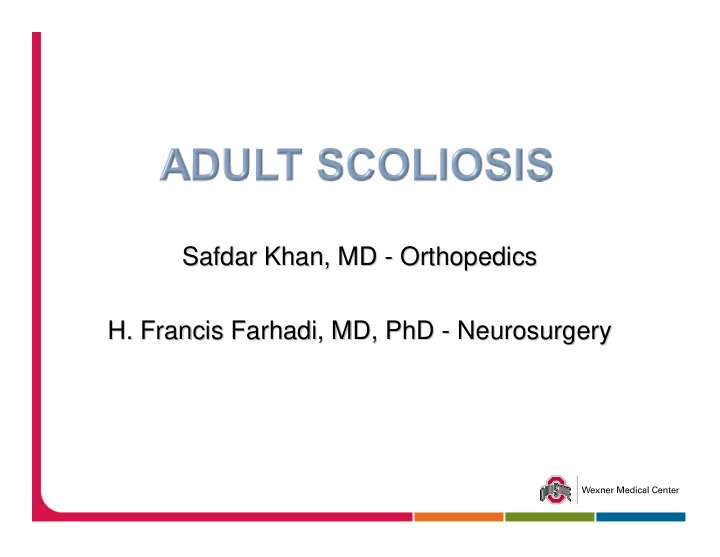

Safdar Khan, MD - - Orthopedics Orthopedics Safdar Khan, MD H. Francis Farhadi, MD, PhD - - Neurosurgery Neurosurgery H. Francis Farhadi, MD, PhD
68 yro F with leg > back pain Worse on the right and with standing/walking ODI 54% Failed PT and injection trials Scoliosis + Spondylolisthesis
Unstable lateral spondylolisthesis at L2-L3 Stable anterior spondylolisthesis at L4-L5
1 yr post-op VAS back and leg 0/10 ODI 20%
Deformity in Coronal and Sagittal Planes Incidence: 2.5-15% Degenerative changes in the intervertebral discs, facets, and osteoporosis Associated with spondylolisthesis, lateral subluxation, and sagittal imbalance Clinical presentation: LBP, neurogenic claudication, radiculopathy, flat-back syndrome Treatment Conservative: NSAIDs, analgesics, PT, brace, injections Surgery
Degenerative Scoliosis Surgical Indications Failure of conservative treatment Significant and progressive spinal deformity Functionally disabling neurological deficits Surgical Techniques Decompression alone Decompression plus fusion (extent of fusion, correction of deformity, posterior vs. anterior/posterior)
Degenerative Scoliosis Degenerative scoliosis presents with varying degrees of curve magnitudes and stenosis Pritzell, Simmons, Dawson, Schwab, etc Ploumis et al, 2008 (mild Grade I, moderate with lateral listhesis Grade II, and severe with global imbalance Grade III) Individualized treatment in terms of levels of fusion, extent of instrumentation, anterior/posterior approaches.
Pitfalls (Patient Evaluation) Clinical symptoms are more important than imaging findings Distinguish deformity vs. degenerative Assess both primary and fractional or compensatory curvature Assess sagittal alignment but distinguish flat-back deformity from lumbar stenosis presenting as sagittal imbalance
Conclusions Degenerative scoliosis presents with varying degrees of curve magnitudes and stenosis Individualized treatment in terms of levels of fusion, extent of instrumentation, anterior/posterior approaches. Decompression only Laminectomy plus fusion with or without instrumentation A/P and/or osteotomy for curve correction for global imbalance Newer techniques XLIF and minimally invasive posterior decompression and fusion Motion preservation (ie, TDR, etc)
Discussion and Questions
Recommend
More recommend